Cuphead was one of the most highly anticipated indie games of 2017 and, while I always enjoy stumbling upon great overlooked games, it’s rather refreshing to see a game with so much hype behind it actually (mostly) live up to that hype. Both visually and audibly Cuphead is an aesthetic masterpiece and this is something that was obvious from the first, painfully brief E3 trailer, but there is a breathtaking world of difference between seeing a few disconnected trailers and brief gameplay demos versus playing it for yourself as one cohesive whole. Even more importantly, it plays extremely well.
There is no denying that aesthetics are a huge part of Cuphead‘s identity, but the sense of awe inspired by technological and stylistic marvels quickly erodes if the gameplay is miserable. It’s true that the handful of platforming areas are short and feel somewhat tacked on and some of the fights aren’t as solid as the others. However, overall Cuphead offers a whimsical world filled with challenging boss fights which are as creative in their mechanics as they are in their designs and it lasts just long enough to feel like a satisfying adventure without overstaying its welcome.
Before diving any deeper into the world of Cuphead there is one thing in particular which is important to keep in mind. Namely, the vast, vast majority of your time with Cuphead will be spent fighting bosses. Yes, it has platforming levels filled to their brims with creative enemy designs, but these six short levels ultimately feel like an afterthought in comparison to over 15 bosses, each of which has at least three phases. Even though they’re fun, they’re entirely optional aside from being your main source of money and creating bridges which serve less as shortcuts and more as ways of making backtracking faster.
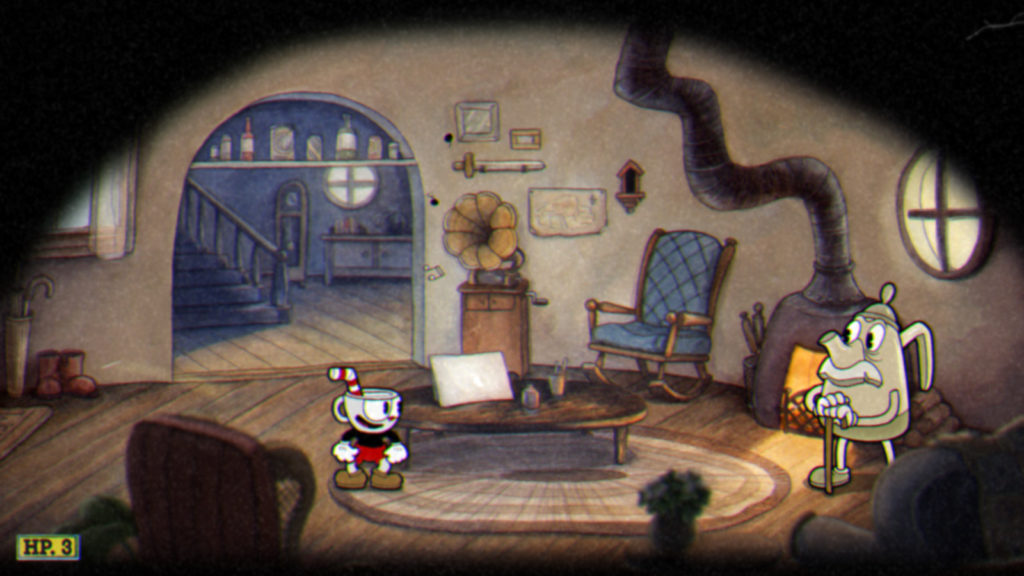
Most of the boss fights would hold up well even if Cuphead wasn’t the aesthetic wonder that it is while the levels, though not bad, would be quickly forgotten in the endless ocean of decent platforming levels if not for their appearances. And that’s all fine! You might be disappointed if you were hoping this action platformer would put a greater emphasis on the platforming side of things than its trailers implied, but it has otherwise firmly delivered on its promise of engaging, memorable boss fights.
To further delay our dive into the depths of this game, I’m going to take a full step back for a moment. Cuphead has been the living definition of an indie darling for years now, but I still want to give a general overview of what it is for anyone who has not followed it too closely (or at all). This game’s big claim to fame is that it’s designed entirely in the style of a 1930’s cartoon and not just because of a film grain effect. Not only are characters drawn in the style of that era with their long noses, toothy grins, massive eyes, and often a bit of nightmare fuel thrown in (or rather a lot in the case of Beppi The Clown), but everything is fully animated in that constantly bobbing, extremely expressive style. What’s more, it has a wonderful big band soundtrack appropriate for the era. Screenshots truly do not do this game justice, even videos don’t quite capture the magic of playing it for yourself, but small, unobtrusive meters for health and special attacks are the only hints screenshots would give of this not being a real 1930’s cartoon. Perhaps most crucially of all, Cuphead has the soul of 1930’s animation.
Old cartoons often have more surreal settings and darker plots than most modern cartoons would be allowed to touch and Cuphead follows suit. Our story begins with Cuphead and Mugman (Player 2 in co-op) winning big at the Devil’s casino, but once the Devil himself shows up they bet their souls on a game of dice and, of course, lose. They strike a deal with the Devil to save their own souls in exchange for bringing him the souls of other debtors in Inkwell Isle and thus the journey to beat up a whole bunch of bosses in exchange for signed soul contracts begins. Despite the dark undertones, Cuphead is an entirely lighthearted affair – it’s not trying to be edgy, it’s simply using a story similar to those so often found in the works it seeks to mimic.
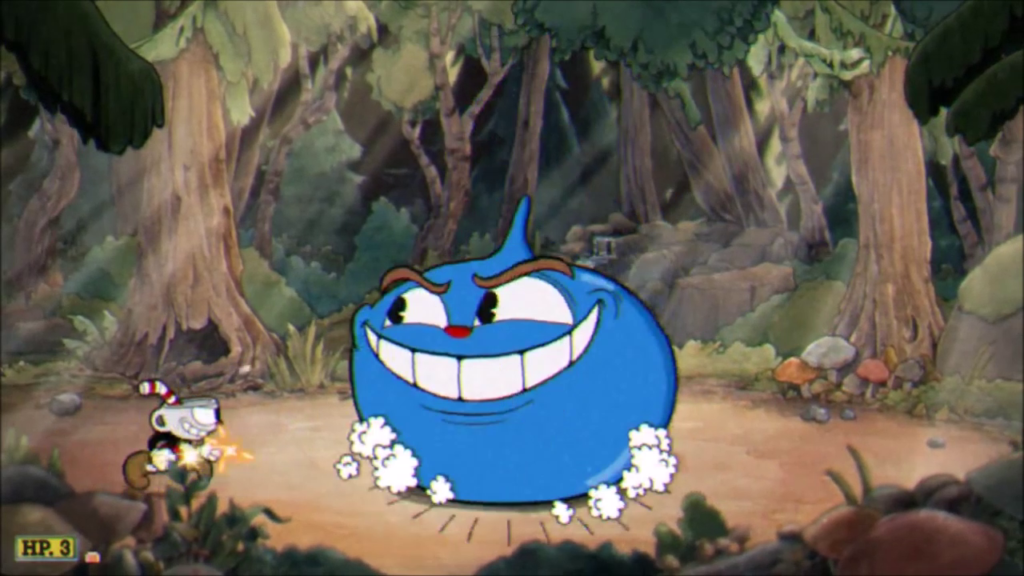
So, what tools does Cuphead actually have at his disposal? The answer is some fairly standard action platformer ones. By default he can rapidly fire his peashooter finger-gun, jump, duck, dash horizontally on the ground and in the air, and parry. Your weapon can be aimed in eight directions and you can lock yourself in place to aim without moving, which frequently comes in handy. A special meter fills up as you deal damage and this is used to perform a stronger attack based on your weapon; the meter can hold up to five charges and you soon unlock access to even stronger EX skills which can be used when the meter is completely full. Coins found in platforming levels and hidden throughout the world map can be used to further expand Cuphead’s arsenal with five additional weapons (two of the six can be taken into each level) and passive charms which do things like making you invincible while dashing or boosting your max health up to five from the default of three in exchange for lower damage.
The parry system is worth talking about on its own and not entirely for good reasons. Pressing the jump button while in the air allows Cuphead to parry anything pink, and this does include everything from energy bullets to earthworms; if it’s pink it can be parried. Aside from serving as a defensive maneuver, parries also bounce Cuphead up into the air and fully fill the current charge on the special meter. All of this sounds fine, great even, but the execution leaves something to be desired.
Parries work exactly as intended with energy bullets and anything round in general for that matter. However, issues sometimes crop up when you’re trying to parry attacks with less perfectly circular shapes. In these cases, parrying from above the attack works fine, but the parry becomes extremely finicky when trying to perform it from the side or below. There were a fair number of times when I was sure I parried something from the side only to take damage instead or, less commonly, to both take damage and bounce from a ‘successful’ parry. Restarting is virtually instantaneous and attacks you can parry are often thankfully front-loaded into the first phase of each fight, but needing to restart because the parry decides to be way more finicky with some objects from some directions than others never feels good.
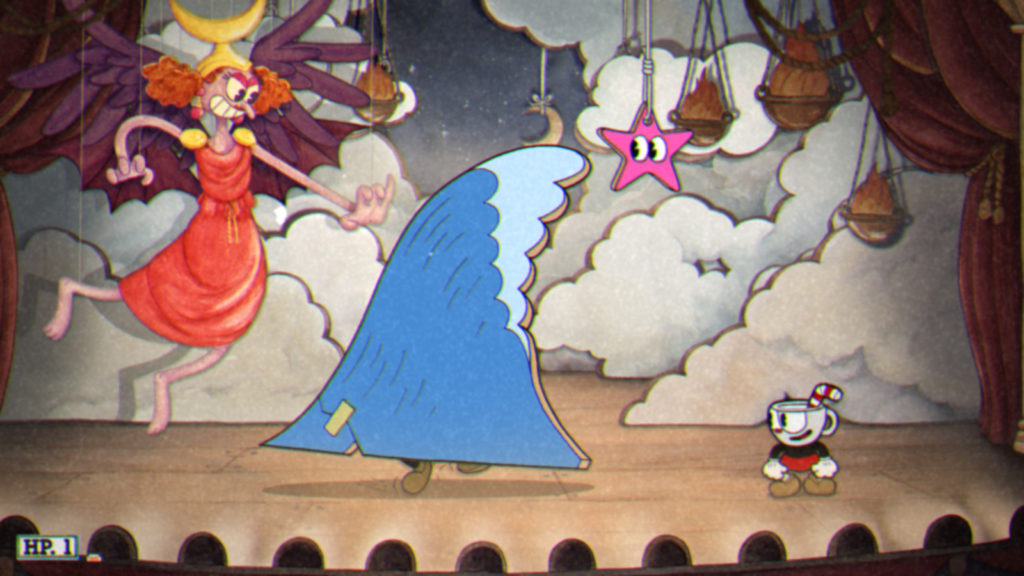
Let’s get down to business and talk about the the bosses since they’re the real stars of the show. At slightly over 15 spread across three worlds plus a few more in a shorter Finale region, there are quite a few of them. Every boss has at least three phases. You can’t see a boss’s health during the fight, but each time you die you can see how far into the fight you got with indicators for phase transitions alongside a little rhyme unique to each phase. Every fight can be completed in under two minutes and with this many phases crammed into that small time frame the fights never get stale. Going beyond the scope of the individual fights, Cuphead is great at varying up how its many bosses treat their phases.
The way boss phases function varies a lot from fight to fight. Bosses like Captain Brineybeard use each phase to build upon the previous one, adding in some additional threat to watch out for on top of the initial attacks and maybe tossing in a big twist near the end. Other fights, like the one against the vegetable trio known as The Root Pack, are boss gauntlets where each phase features an entirely different boss. Yet others are against a single boss which changes up its attacks so dramatically between phases that it’s essentially a new boss each phase aside from one or two elements which carry over, such as the dangerous roller coaster which periodically rushes in from the background while fighting Beppi The Clown.
Often, bosses fights are some combination of these types, containing two or three distinctive phases against the same boss only for a radical transformation to occur or for an entirely different boss to show up at the end. You need to defeat every boss in an area before you’re allowed to move to the next one, so it’s great that these fights are so varied and that you can usually pick between at least two of them when deciding which one to fight next.
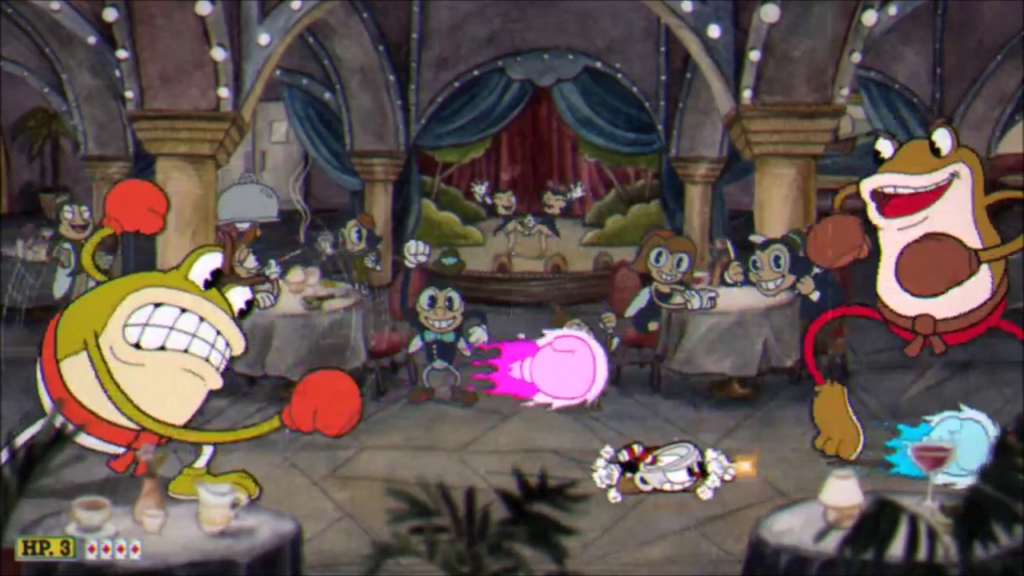
One type of fight I haven’t mentioned yet is the plane fight. Five bosses are shmup-style bosses which you fight in an airplane and, considering how they account for nearly a full third of the fights in the game, they’re definitely worth discussing. While in the airplane you can move anywhere and you always shoot to the right like in a standard horizontal shmup. As there is no jumping, you can parry pink attacks at any time. The biggest difference is that instead of a dash you can turn your plane into a smaller, faster target at the expense of significantly reducing your attack range. Your default weapon in the plane is a machine gun, but in the second world you get access to a bomb you can lob downward which deals both direct contact damage and explosion damage; you can swap between both weapons at any point in plane fights once you have them. Like with the normal weapons, you have super attacks you can build up and they do different things based on which weapon is equipped. As for your ultimate EX move, your plane transforms into a rocket and you need to directly crash yourself into the boss to damage it while avoiding attacks; it’s a great move that fits right in with the setting while providing the potential for massive damage or at least for absorbing a hit.
As for the plane bosses themselves, I think they are a bit too common, one per area would have sufficed, but they’re still great for the most part. From the frequent transformations of Hilda Berg to the particularly bizarre attacks of Djimmi The Great, one of which involves him turning into a series of stone pillars, the plane fights keep themselves varied. Cala Maria, a massive mermaid in the third area, is even one of my favorite bosses in the game with tons of attacks and many surprises. On the other hand, the other plane boss within the same area is the only boss in Cuphead I really don’t like with a first phase consisting of multiple attacks which don’t synergize well and a final phase which is overly simple and goes on for way too long.
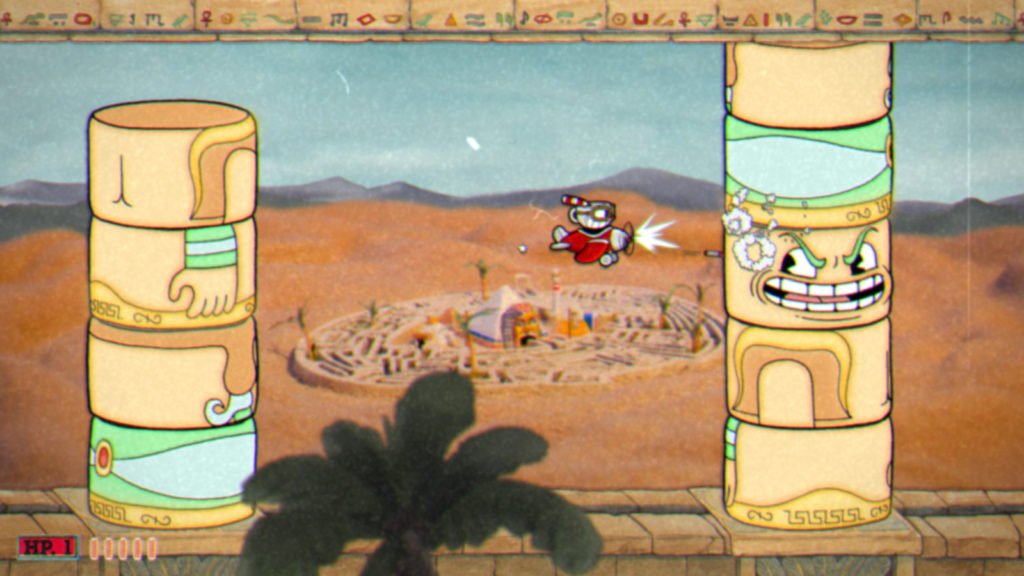
Cuphead wouldn’t be the same without its aesthetics. Yes, its look is the main reason for its popularity, most people wouldn’t have so much as batted an eye at the early trailers based on the gameplay alone, but its more than that. Cuphead incorporates all the whimsical, abstract nonsense and exaggerated expressions of of a 1930’s cartoon directly into its gameplay. Just about anything can happen thanks to the fluid style this game has chosen. A pair of boxing frogs can turn into a vending machine. A dragon can suddenly sprout two more heads and one of those heads can in turn breath fire at you by turning into a flamethrower. A massive carrot can assault you with psychic powers, because why not? Nothing has to follow any sort of logic because this game is a 1930’s cartoon where style takes precedence over sense. Fights are capable of being so dynamic and surprising in large part thanks to the aesthetic.
You may be thinking that the look of the game doesn’t really tie all that much into the gameplay on a technical level. After all, every boss is still basically a giant hitbox and their attacks are in turn hitboxes; you can put anything you want on a hitbox and it’s still going to function in the same way even if it looks boring. Except, there is a key element here where animation makes all the difference – boss tells. Bosses have a lot of attacks in each phase and they change up the order of those attacks every time you fight them so memorization can only help you so much.
However, it turns out that the over-the-top expressiveness of 1930’s animations translates extraordinarily well into video game form as it allows every attack a boss performs to have a unique, clearly visible warning. Tells are often tricky to pull off well in demanding boss fights, they’re often so fast and subtle that they’re easy to miss or so similar to each other that you can’t easily ‘tell’ them apart, but here the aesthetics are an immense aid; you’ll know what a boss tell is about to lead into after the first time the boss uses that attack.
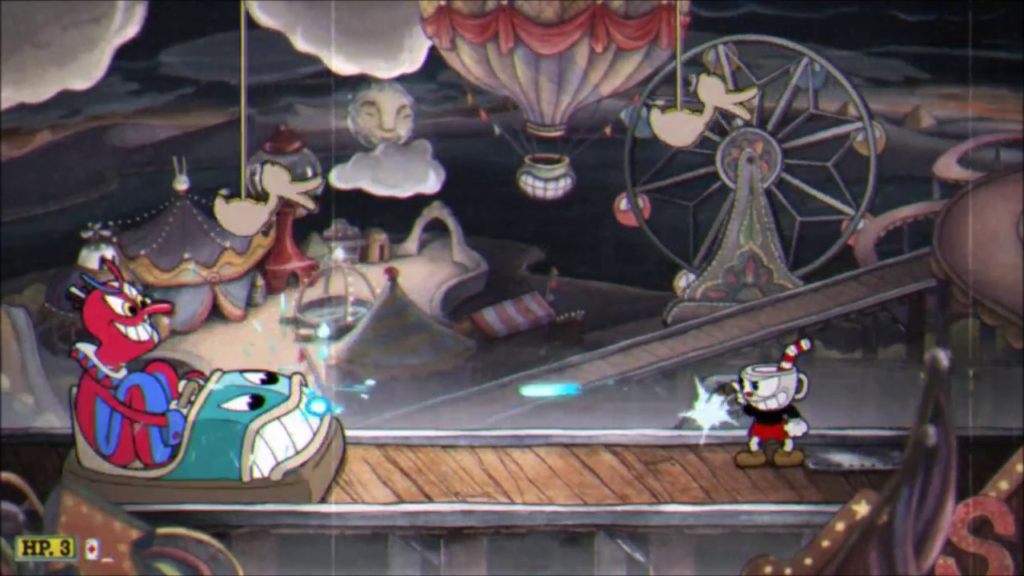
Make no mistake, even with its unique look Cuphead is still mostly a traditional boss-focused action platformer. If you’ve never been a fan of games which consist almost entirely of boss fights, then this one is probably not going to be the exception to the rule. Each fight may take less than two minutes, but you’re expected to take hours to reach the end after suffering through dozens, likely hundreds, of defeats. The tells themselves may be clear, but the attacks are frequently abrupt once they are launched and many of them are unusual, making it easy to get hit the first time you encounter a new attack even if the tell saves you from it in the future.
Similarly, you can more or less use whichever attacks and passive bonuses you want for any fight, but some fights are made far easier with certain weapons and the only way to really find that out is to learn the fight through failure (or looking the fight up online). These elements are all par for the course when it comes to boss-focused games as failure is meant to be a treated as a learning experience and the abrupt, aggressive attacks allow the fights to remain challenging even after you know every trick the bosses can throw at you. That said, if you’re not a fan of games built around gradually learning fights through repeated, expected failures, then you’re probably not going to be a fan of Cuphead even if you love its style.
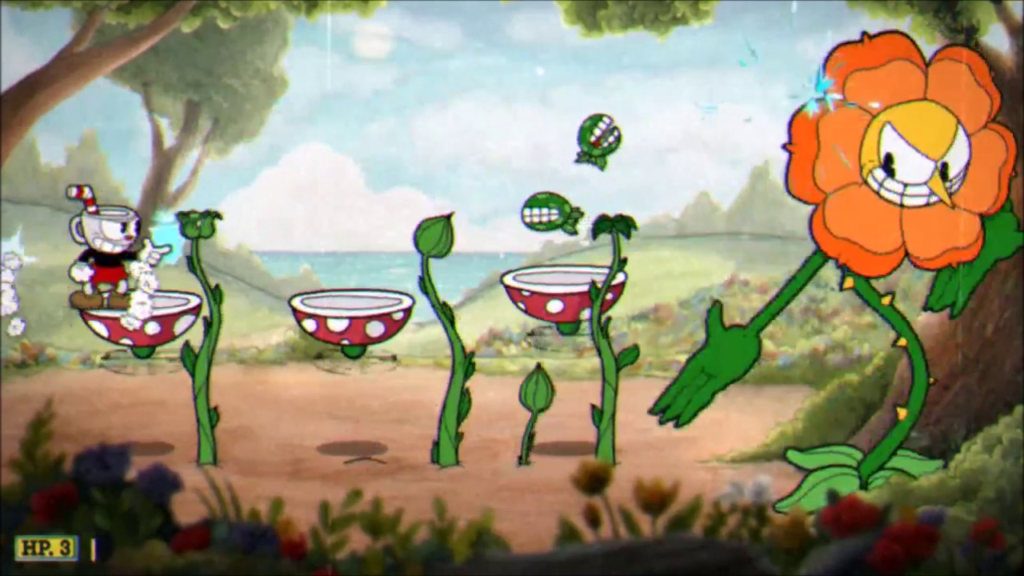
In general, Cuphead is good at making itself accessible to players of all skill levels. Initially, just about every boss can be fought on Regular or Simple difficulty. Regular provides plenty of challenge even for those experienced with action platformers while Simple takes away a large amount of the difficulty for newer players. On Simple, boss attacks tend to be slower and if they have projectiles there are fewer of them. Additionally, from the fights I tested on Simple, it seems like each fight has an entire phase taken out of it (usually the last phase, but not always).
There’s a pretty significant gap between Simple and Regular and this allows players who care more about the aesthetics than the gameplay to have a decent challenge without feeling overwhelmed. On the other side of the spectrum, those seeking a challenge can unlock Expert mode after completing the game, which isn’t quite the leap up from Regular that Regular is from Simple, but it does make bosses much faster and more aggressive while sometimes throwing in a small twist or two. Last of all, it’s worth mentioning that you get a grade after each fight, but this has no impact beyond unlocking some achievements and at least one (admittedly rather cool) style option.
Though Cuphead is mostly good when it comes to difficulty, this is also where it hits a few stumbling blocks. The biggest, most noticeable offender here is the lack of a Simple option for the Finale fights. It’s a mystery as to why the developers would allow players to enjoy the vast majority of the game on this difficulty if they choose to do so only to violently rip the rug out from under their feet by forcing them to attempt some of the hardest fights in the game on a higher difficulty setting than they are accustomed to, but it’s a terrible decision. Content outside of boss fights only has a single difficulty setting, but this is largely fine for platformer levels as most of them aren’t too difficult and there are enough coins hidden outside of these levels that players can still buy a fair number of upgrades in the shop. Where this fixed difficulty falls apart a bit is in the three mausoleum levels.
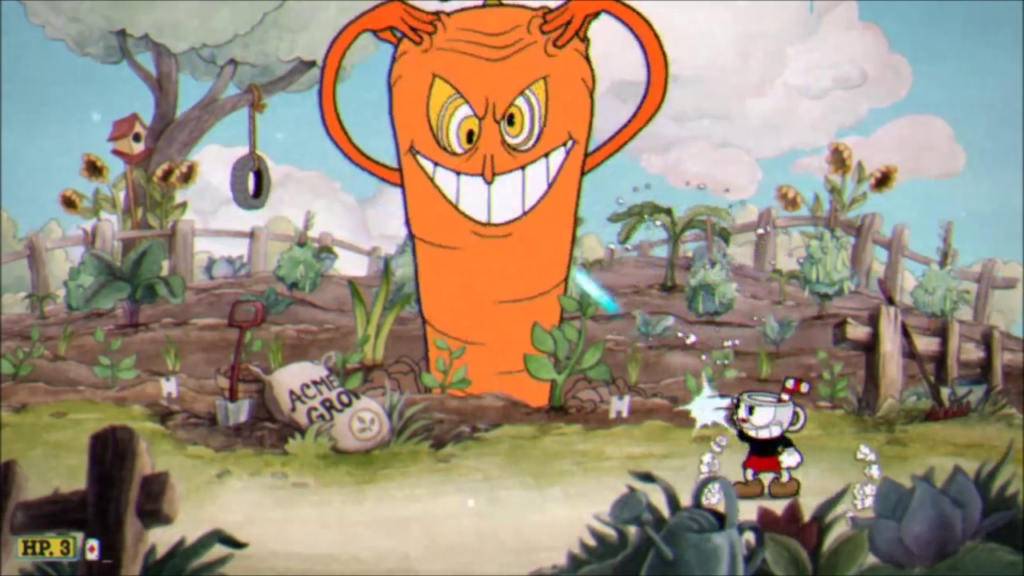
Mausoleums are where you go to obtain your EX skills and they have the opposite issue of the Finale levels. They are simply far too easy. In these levels, you have to defend an urn from waves of ghosts. You can’t directly hurt the ghosts and they can’t hurt you. However, these ghosts are pink so you need to parry them to defeat them. EX skills are useful enough that the way to get them shouldn’t be too difficult, but these mausoleum levels can go on for a while and their the only points in the game where I started to feel outright bored. You can’t go back into the mausoleums after beating them either, which just makes these levels feel even more pointless. Using parry against ghosts in this way is a neat idea, but the execution leaves much to be desired and the mausoleums ultimately prove to be little more than the resting places of wasted potential.
A few more minor issues exist with certain bosses. Hit boxes are sometimes not entirely obvious as sometimes your attacks will pass through parts of a boss’s body which the game deems as ‘unimportant’ and at other times objects which seem like they count as part of a boss’s hitbox will end up blocking your shots. As much as I like the Cala Maria fight, Cala Maria herself is also the biggest offender when it comes to this issue. She has a squid which serves as her hair, but it’s only a solid object and not part of her own hitbox. This is a particularly nasty issue for this plane boss because if you drop bombs on her from above she’ll flash as though she’s been hit, but she’s really only taking small amounts of chip damage from the explosions; it wasn’t until I switched to the machine gun that I realized why she seemed to have so much more health than the other plane bosses.
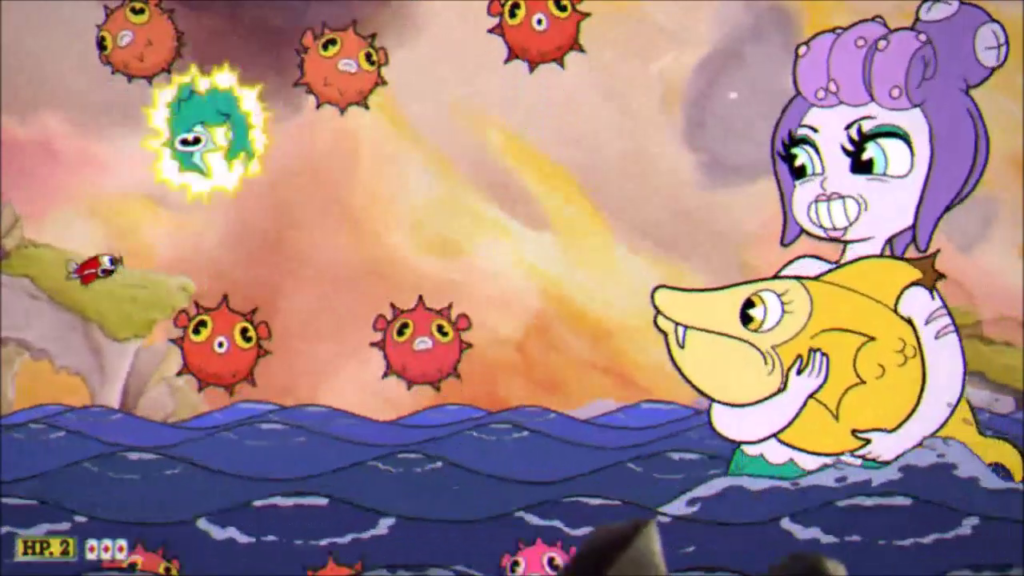
A final issue to note is that, while tells are usually quite good, a few boss attacks could use a bit more warning. A giant bee boss, Rumor Honeybottoms, is particularly bad at giving warnings in her second phase as she drops to attack from above and gives a warning hand in advance if she’s attacking from the sides, but if she decides to launch her central attack she appears immediately without any visual cues, forcing players to completely avoid the center any time she’s not already onscreen.
Cuphead is an all-around delight which even now I can’t seem to stop playing as I continue to chip away at the elusive goal of getting perfect grades on every Expert boss fight long after having watched the credits roll. Anyone who likes boss-focused action platformers, especially ones from the Genesis era like Gunstar Heroes, will almost certainly fall in love with this game as it’s just about as solid and satisfyingly challenging as such a game can get. If you love the style while being lukewarm on this type of gameplay, you can still get enjoyment out of most of the game by admiring the aesthetics while playing on Simple. There are issues here, chief among them the lack of Simple settings for the Finale area and the questionable parry detection in some fights, and anyone who can’t stand the thought of potentially needing to retry some boss fights dozens of times is likely not going to be won over enough by the aesthetics no matter how good they are, yet Cuphead‘s strengths are so incredible and the journey as a whole is so legitimately awe-inspiring that I can’t help but to say that Cuphead is every bit as much of a classic as the works it emulates so perfectly.